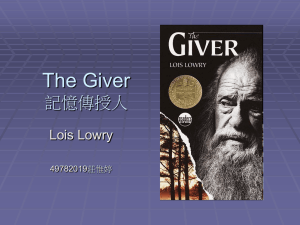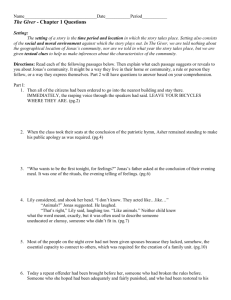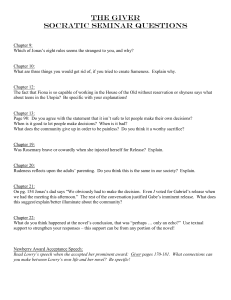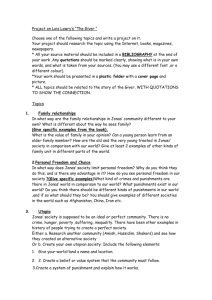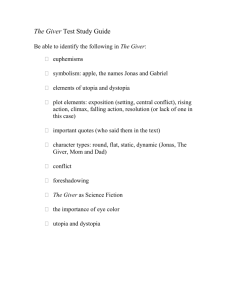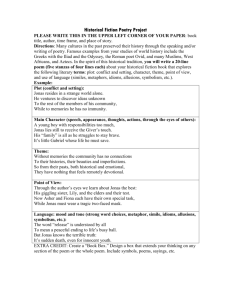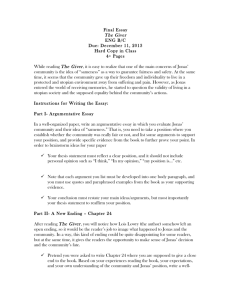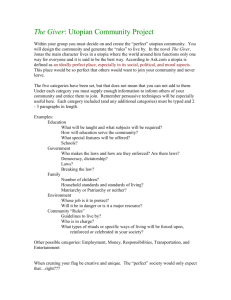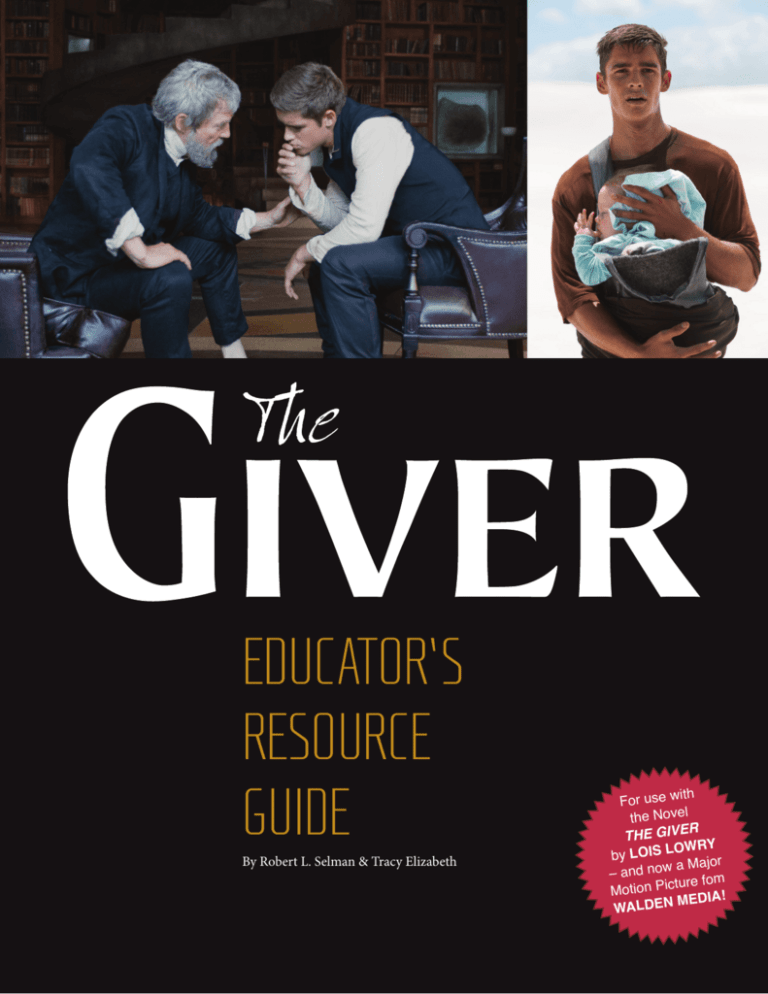
EDUCATOR’S
RESOURCE
GUIDE
By Robert L. Selman & Tracy Elizabeth
ith
For use w
e
the Nov l
R
THE GIVE
W
O RY
by LOIS L
a Major
– and now
ture fom
Motion Pic
MEDIA!
WALDEN
The Giver | Educator’s Resource Guide
Table of Contents
THEORETICAL FRAMEWORK FOR THIS RESOURCE GUIDE…………….....…… 1
PART 1: GETTING TO KNOW THE COMMUNITY……………….......................…… 2
PART 2: JONAS’S SELECTION AS RECEIVER OF MEMORY……….................… 7
PART 3: JONAS QUESTIONS THE CONVENTIONS OF HIS COMMUNITY…..... 12
PART 4: JONAS REJECTS THE ETHICS OF THE COMMUNITY………………… 17
CULMINATING 3E ACTIVITY FOR THE GIVER…………………………..............… 22
RECOMMENDATIONS FOR DISCUSSION ACTIVITIES……..…......................… 23
STRATEGIES FOR FACILITATING HEALTHY DISCUSSIONS……………….…… 24
ROBERT L. SELMAN is the Roy E.
Larsen Professor of Human Development and Education and Professor of
Psychology in Psychiatry at Harvard
University; 609 Larsen Hall, 14 Appian
Way, Cambridge, MA 02138; email:
robert_selman@harvard.edu
He conducts research on social
development and its integration with
curriculum and instruction in elementary and secondary schools and with
social media, including websites, social
networking, and entertainment.
TRACY ELIZABETH is a doctoral
student in the Human Development
and Education program at Harvard
University; 611 Larsen Hall, 14 Appian
Way, Cambridge, MA 02138; email:
tracy_elizabeth@mail.harvard.edu;
website: www.tracy-elizabeth.com
Her research focuses on the promotion
of children and adolescents’ academic, social, and moral development
through education curricula and
entertainment media.
Excerpts from THE GIVER by Lois Lowry. Copyright ©1993 by Lois Lowry. Used by permission of Houghton Mifflin Harcourt.
All rights reserved. Page numbers for each excerpt refer to the hardcover edition of THE GIVER, ISBN: 978-0-547-99566-3
The Giver | Educator’s Resource Guide
3E
A Theoretical Framework to Bridge
the Narratives of Books and Films1
Education
How does the story promote critical thinking and deep comprehension?
The Education activities are designed to engage youth in rich critical thinking exercises that deepen
their comprehension of content matter and extend their reasoning skills beyond factual inferences from
the texts. The activities include ways to broaden background knowledge through research, discussion,
and writing.
Ethics
How does the story promote dialogue and ethical reflection?
The Ethics activities are designed to engage youth in high-quality dialogue centered on characters’
perspectives and ethical dilemmas presented in and inspired by the texts. They are based on empirical
research focused on the promotion of students’ societal-, social- and self-awareness, typically through
understanding the thoughts, feelings, and motivations of the characters in the story, as well as their own.2
Entertainment
How does the story promote creativity and capture character identity?
The Entertainment activities are designed to engage youth in exercises that align dramatic events in
the film to those in the book, and to nurture young peoples’ creative potential and identification with
characters in the texts. These activities include methods that empower students to consider how the
author and screenwriter structured the plot to enhance readers’ and viewers’ engagement with the story.
The activities in this resource are appropriate for youth of varying ages and developmental stages
of literacy and social awareness. Nevertheless, all of the questions and concepts introduced here
can be thoughtfully considered by learners across the upper elementary and secondary levels, as
well as by adult learners in college and beyond. Still, we recommend that the educator be aware
that students’ social sophistication and cognitive maturity will play an important part in his or
her understanding and interpretation of events in the story.
Note: The content on pages 23-25 offers descriptions of the different types of discussion formats,
including structured debate, that are conducive to quality dialogue among children and adolescents.
For each activity, we recommend that educators select the format that best suits their students.
1 Selman, R. L. & Kwok, J. (in press) Counting Hearts and Eyeballs: How to Help Adolescents Make Better Decisions Using Entertainment and the
New Media (and Know that You Have Succeeded). To appear in Kornhaber, M. and Winner, E. ( Editors ) MIND, WORK, AND LIFE: A Festschrift on
the Occasion of Howard Gardner’s 70th Birthday.
2 Selman, R. L. (2007). The promotion of social awareness: Powerful lessons from the partnership of developmental theory and classroom practice.
New York: Russell Sage Foundation.
1
PART 1
Getting to Know
the Community
EDUCATION
GROUP WRITING:
Encourage students to create a Pros & Cons list of Community attributes. What are the good things about Jonas’s
Community? What are the bad things? Keep this list and add to it as students travel through the story.
The Community
CONS
1. There are no wild animals or pets in the
Community.
PROS
1. The Community is very orderly.
2. People are always polite.
2. Youth do not pick their own jobs.
3. There is no poverty; everyone has a job.
3. Children do not choose their own clothes
or styles.
PERSONAL WRITING:
Ask students to write extended responses to the following questions: Why do you think there are no animals
in the Community? How did this happen? Imagine your own world without animals. How would life
be different?
2
DISCUSSION:
Invite students to ponder: What consequences may occur if the following happened in the Community?
For each, challenge students to consider what type of punishment, if any, would be assigned.
• Writing derogatory slurs on a wall
• Taking someone else’s bike
• Teasing a sibling for doing poorly on a test
• Biking to another community
• Refusing to accept someone’s apology
IRONY
Irony is a literary technique that contrasts the expectations of a situation with the events as they actually
happen. For example, the way Jonas’s Community uses the term “voluntary” to describe required
community service is ironic.
MUSIC CONNECTION:
Invite students to listen to Alanis Morissette’s song Ironic. Encourage them to consider the lyrics and identify some
of the ironic situations Morissette references.
CIVIC ENGAGMENT:
The youth in Jonas’s Community are required to do a certain amount of volunteer work. This is ironic. How can
someone be required to volunteer? Should volunteer work be required of youth in your community? Why? Press
students to justify their argument (their beliefs about how the world operates) with logic or evidence (experiences
they have had with this type of activity). As a class, develop a service-learning project that you can complete
over the course of the year to make a positive difference in your own school or community. Create a list of the
project goals, and include student-generated strategies for ways to ensure that the project will be successful. Ask
students to compare their own program with the volunteerism found in The Giver.
3
ETHICS
DISCUSSION:
Pose the following discussion prompt: What is the significance of rules in Jonas’s Community? Why are some
rules socially acceptable, while others are strictly forbidden? For example, we learn that teaching a younger sibling
to ride a bike is forbidden, yet happens often and is almost expected within the Community. Alternatively, we later
learn that hoarding snacks is against the rules and will result in public chastisement.
To extend this discussion, encourage students to think of how we learn the rules of our own culture. Invite students
to make a list of five very important rules in our culture, and then discuss with a partner: Which rules are
more important than others? Why?
DEBATE:
Divide students into three teams to consider the following dilemma: The Community used shame to reprimand
Jonas for taking the apple home, yet no one ever spoke of it directly. In fact, a large function in the Community is
to avoid disgrace. Ironically, Jonas was publicly, yet privately shamed. Do you think this shaming was a fair way
to address Jonas’s transgression? Team A will argue in favor of Jonas’s punishment. Team B will argue against
it. Encourage students to elaborate on how they know when the punishment fits the crime. Team C, a team of
unbiased judges, will listen to the arguments of the opposing teams and will conclude the debate by offering a
collaborative solution that integrates the differing perspectives.
DISCUSSION:
In the novel, at the family dinner table Lily tells a story about young visitors at her school who do not “obey the
rules.” Father challenges Lily to take the other children’s perspectives:
“I felt very angry this afternoon,” Lily announced. “My Childcare group was at the
play area, and we had a visiting group of Sevens, and they didn’t obey the rules at
all. One of them—a male; I don’t know his name—kept going right to the front of
the line for the slide, even though the rest of us were all waiting. I felt so angry at
him…”
“Why do you think the visitors didn’t obey the rules?” Mother asked.
Lily considered and shook her head. “I don’t know. They acted like… like…”
“Animals?” Jonas suggested. He laughed.
“That’s right,” Lily said, laughing too. “Like animals.”
…Father was listening with interest. “I’m thinking, Lily,” he said, “about the boy
who didn’t obey the rules today. Do you think it’s possible that he felt strange
and stupid, being in that new place with rules he didn’t know about?” [The Giver,
pages 6-8]
4
Encourage students to come up with strategies that Lily and her classmates could have adopted to make the
visitor feel more welcome and comfortable.
To extend the discussion, ask: “From where has the visitor come? What happens when someone moves to a place
where the customs and rules of society are different?” Then encourage students to share a personal story about
a time in which they were in a similar situation where they felt strange and/or foolish for not knowing the
rules. How did others make the situation feel better… or worse?
PERSPECTIVE-TAKING DILEMMA3
WRITING:
Explain to the class that, in real life, students are faced every day with the kind of situation that Lily shares
with her family unit at dinner. Next, ask them to write their reactions to the scenario below.
Imagine that you encounter the following situation:
You have lots of friends in your class this year and you are enjoying school. In January, your
teacher introduces a new student to the class, Jariah, who has recently arrived with family from
a different city. Jariah’s hairstyle is really strange. Also, your classmates do not like the music
Jariah listens to. Some students tease Jariah because they think Jariah is weird.
A. Casey is a student who has been witnessing the situation and doesn’t know what to do. Suppose Casey
comes to you for advice.
1. What would you recommend to Casey?
2. Why would you make that recommendation to Casey?
3. What might go wrong with your recommendation?
B. Compare this situation to the one Lily reports about the visitors in her school.
1. Would Jariah’s situation occur in Lily’s Community?
2. How is Jariah’s situation similar?
3. How is it different?
3 For further information on The Perspective Taking Dilemmas presented in this resource, contact Robert L. Selman at Robert_Selman@Harvard.edu
5
ENTERTAINMENT
READER’S MOVIE THEATER:
In both the book and film, we get a sense of the characters’ apprehension as they prepare for the ceremony in
which they will be assigned jobs. Consider the following excerpt from the screenplay:
ASHER:
So this is it. Last night of childhood.
FIONA:
I guess everything is going to be different.
A moment of hesitation.
JONAS:
No. Tomorrow, the only thing that changes is what we do. But what doesn’t change
is who we are.
ASHER:
(Smirks) Quick question: Who are we?
JONAS:
Well, I guess, we’re… the three of us. I mean, we always have been.
FIONA :
(Overly grand) And so we always shall be.
They laugh.
ASHER:
Friends. Even when you’re both assigned to be Birth Mothers…
DISCUSSION or WRITING:
Encourage students to reflect upon the following questions:
1. Why would Asher be worried that this is their last night of childhood? And, do you think Jonas’s
response is comforting to Asher and Fiona? Why?
2. How do friendships change across the duration of the story? What causes these changes?
3. With which character in the story do you most closely identify or sympathize? Why?
6
PART 2
Jonas’s Selection as
Receiver of Memory
What is a Turning Point?
A character’s turning point is a moment within the story where the character changes his thoughts,
feelings, or attitudes. This change is typically inspired by conflict. Other times, a turning point is ignited
during moments when the character has encountered a crisis or learned something important enough to
change his outlook and the story’s direction.
CHARACTER TURNING POINT
After Jonas learns that he has been selected to be the
Receiver of Memory, he experiences mixed feelings
of both pride and fear. How does this selection change
Jonas? For the first time ever, Jonas learns what it’s
like to feel different and slightly alienated from
his Community.
7
EDUCATION
DISCUSSION:
Ask students to consider: Why are Jonas and others in the Community only exposed to a limited set of books
(dictionaries, descriptions of Community offices, lists of Rules, etc. [The Giver, page 94])? What types of reading,
if any, did they do in school? How would the absence of fiction and historical texts affect Jonas’s life?
Ask students to reflect on the following: How would the absence of fictional stories affect your life, personality,
and perspective of the world? What about the absence of historical texts?
DISCUSSION:
Invite students to imagine the possible discipline issues that occur during an average week at Jonas’s school. In
what ways would students in the Community break the rules? What behaviors are considered to be serious
infractions at Jonas’s school? How do you imagine these discipline issues are resolved? Who handles them?
CREATIVE HISTORY:
Encourage students to use their imaginations to create a timeline of major historical events that happened in
Jonas’s Community over the past 100 years. Ask them to provide titles and brief summaries of each event, and
to illustrate key moments.
WRITING:
Remind students of the five qualities that a Receiver must have: Intelligence, Integrity, Courage, Wisdom, and
the Capacity to See Beyond. Describe what each of these traits means to you and identify examples of ways
one may demonstrate them.
To extend this exercise, ask students to rank order the most to least important of the character traits noted above.
Encourage them to justify why they view some traits are more valuable than others.
WRITING & DISCUSSION:
Jonas gets a startling new set of rules along with his new “job.” On poster board or chart paper, ask students to
write down the list of Jonas’s new rules. Next, ask students why they believe Jonas received these particular
rules. What might their different purposes be?
Keep this list posted and return to it when students have completed the story. Consider how the significance of
each rule changes as the story progresses.
WRITING:
Continue to add to your list of Pros & Cons of the Community. What are the good things about it? What are the
bad things? Make a note of things that you change on your list and explain why you have changed your mind about
their value.
8
ETHICS
DISCUSSION:
Talk with students about the difference between being assigned a job versus being selected for a job. Ask: Why is
being “selected” thought of as more of an honor, if one cannot really refuse the selection?
DEBATE:
Jonas is most struck by the new rule that he is allowed to lie. Consider the following excerpt from the book:
Finally he steeled himself to read the final rule again. He had been trained since
earliest childhood, since his earliest learning of language, never to lie. It was an
integral part of the learning of precise speech. Once, when he had been a Four,
he had said, just prior to the midday meal at school, “I’m starving.”
Immediately he had been taken aside for a brief private lesson in language precision. He was not starving, it was pointed out. He was hungry. No one in the
community was starving, had ever been starving, would ever be starving. To say
“starving” was to speak a lie. An unintentional lie, of course. But the reason for
precision of language was to ensure that unintentional lies were never uttered.
…He had never, within his memory, been tempted to lie. Asher did not lie. Lily
did not lie. His parents did not lie. No one did. Unless…
Now Jonas had a thought that he had never had before. This new thought was
frightening. What if others—adults—had, upon becoming Twelves, received in
their instructions the same terrifying sentence?
What if they had all been instructed: You may lie?
His mind reeled. [The Giver, hardcover edition, pp. 70-71]
DEBATE
OPTION #1
Divide students into three teams to consider the following: Why is permission to lie particularly startling to Jonas?
How does lying affect others in the Community? Next, ask the teams to debate the following topic: Is there ever
a time in your own life when it is okay to tell a lie? And is there a difference between a big lie and a little lie?
Team A will argue against lying; Team B will argue that lying is often harmless and necessary for good. Team C,
a team of unbiased judges, will listen to the arguments of the opposing teams and conclude the debate by offering
a collaborative solution that integrates differing perspectives that were introduced.
9
DEBATE
OPTION #2
Divide students into three teams and challenge them to contemplate the following: Consider the concept of “lying”
from a larger societal perspective. What if a society found a way to get rid of lying in the community? Imagine a
society that requires everyone to wear a lie detector device at all times. If the detector found out that someone
had lied, the information would go to the authorities (teachers, police, or judges). Is this a good idea? Team
A will argue that the mandatory use of lie detectors is a violation of human rights and would be harmful to the
society; Team B will argue that the mandatory use of lie detectors would eliminate harmful dishonesty and crime,
therefore enhancing the safety and harmony of the society. Team C, a team of unbiased judges, will listen to the
arguments of the opposing teams and conclude the debate by offering a collaborative solution that integrates
differing perspectives that were introduced.
DEBATE:
The Elders decided long ago to adopt Sameness, Climate Control, etc. to protect its members. Consider why the
Elders would make this choice, then think of your own world. What would you do if you were a town leader who
wanted to protect your citizens from suffering? Divide students into three teams to debate the following: How
much protection should a community offer and how much autonomy and choice should citizens have? Team
A will advocate for Sameness as an effective and humane way to protect the Community, while Team B will oppose
Sameness as a cruel and oppressive form of dictatorship. Team C, a team of unbiased judges, will listen to the
arguments of the opposing teams and conclude the debate by offering a collaborative solution that integrates the
differing perspectives that were introduced.
To extend this activity, ask each team to make a list of both the advantages and disadvantages of Sameness and to
agree as a team what the greatest risk and greatest benefit would be. Then, as a whole class, compare lists.
DISCUSSION:
Jonas’s new set of rules allows him to behave in ways that go against many norms in his Community’s culture.
Encourage students to think of culturally confusing or “foreign” norms they have encountered in their own lives.
(For example, in America, it is quite rude to slurp your soup at the dinner table, but in Japan this is a sign that you
are enjoying the meal. A more common example may be that at your own house, you are allowed to wear shoes
inside, yet at a friend’s house you are required to take your shoes off before entering.) Ask: Have you ever been in
a situation where the “norms” or “rules” were different than what you were accustomed to? How did this make
you feel? What did you do to adapt to this difference?
ENTERTAINMENT
SCREENWRITER’S PURPOSE:
Why, as Jonas receives memories from the Giver, does the movie transition from black and white to color?
What parts of the story inspire color? (Possible response: The more memory and emotion Jonas gets, the more
colorful and rich his life appears to be.)
READER’S MOVIE THEATER:
When the Giver meets Jonas for the first time, he tells Jonas that with memory comes pleasure and pain. Jonas
learns that the Receiver of Memory’s role is to provide guidance to the Council of Elders by evoking wisdom from
10
the memories of the past. Consider the following excerpt from the screenplay, where Jonas experiences his first
memory (snow sledding), and then questions why others in the Community can’t have memories:
JONAS:
Well… Why… why don’t we have… [Struggling to find the words.] That thing—
GIVER:
Come on. The memories gave you the words. It’s not a “THING.” It’s a…
GIVER: Sled.
JONAS: Sled.
JONAS:
And the… the…
GIVER:
Snow.
JONAS:
Snow. Did my parents have them? Did you?
GIVER:
No, it’s a very distant memory. Simply stated, there’s no snow because of climate
control.
JONAS:
But… but why don’t people KNOW about them? What’s so dangerous about the
memory of a SLED?
GIVER:
What’s so dangerous? [He scoffs.] For a sled you need snow. But snow is cold.
Cold destroys crops. Which meant farmers can’t farm, people can’t eat, then
comes hunger, starvation, famine… Everything is connected. Everything is a
balance. With good there is always bad. The two are—
He intermingles his fingers. JONAS barely hears THE GIVER.
JONAS:
[Expectant, rolling up his sleeves.] Show me more.
DISCUSSION or WRITING:
Encourage students to reflect upon the following questions:
1. What does it mean that with memory comes pleasure and pain? Is memory worth the pain? Explain.
2. This scene gives us some explanation for why the Elders adopted Climate Control. How do you feel
about this decision? Do you believe Climate Control would benefit our society?
3. What memories of the past have helped you to make wise decisions in the present? How?
11
PART 3
Jonas Questions
the Conventions of
His Community
CHARACTER TURNING POINT
Jonas challenges Sameness; he struggles to understand why the Community has adopted Sameness as
a cultural norm. Jonas argues that the Community
should not have taken differences away.
EDUCATION
WRITING:
Challenge students to consider how schooling is portrayed in the story. What types of subjects do Jonas and his
peers study in school? Consider the following excerpt from the book:
School seemed a little different today. The classes were the same: language and
communications; science and technology; civil procedures and government. But
during breaks for recreation periods and the midday meal, the other new Twelves
were abuzz with descriptions of their first day of training.[The Giver, page 112]
12
Compare Jonas’s classes to your own. How are the subjects similar? Different? Further, think about what it means
to be a teacher in the Community. Put yourself in the shoes of two characters from the story and write about
what typical school day in the Community would be like for each of them.
RESEARCH:
When he is first learning about memory, Jonas wants to remember the experience of sledding again, but he is
confused by how to do this. The Giver tells Jonas to “call back the memory of the ride on the sled.” [The Giver, page
117] Jonas did not realize that he could retrieve his own memories without the help of The Giver. How do our
brains actually work to save memories? What is the difference between short-term and long-term memory?
PREDICTIONS:
Given what you know about Jonas’s ability to “see beyond,” what do you think “hearing beyond” would mean?
WRITING:
Jonas gets upset when children are playing war with imaginary weapons, attacks, and death. “Don’t play it anymore… It’s a cruel game,” Jonas pleads with Asher. (The Giver, page 168) Why does Jonas react this way? Do you
agree that children shouldn’t “play” war? How do you feel about other media (video games, music videos, etc.)
that portray violence?
WRITING:
Continue to add to your list of Pros & Cons of the Community. What are the good things about it? What are the bad
things? Make a note of things that you have changed on your list and explain why you have changed your mind about
their value. Many readers tell us that the more they deeply think about this story and discuss it with others, the more
they begin to see how much we take for granted in our own society. When reading The Giver, one begins to learn that
the rules of the Community are actually intended to alleviate the same types of pains and problems we face in our
own world.
ETHICS
DISCUSSION:
About midway through the story, we see that Jonas begins to question the conventions of his Community. Consider
the following excerpt from the book:
“It isn’t fair that nothing has color!”
“Not fair?” The Giver looked at Jonas curiously. “Explain what you mean.”
“Well…” Jonas had to stop to think it through. “If everything’s the same, then
there aren’t any choices! I want to wake up in the morning and decide things!”
[The Giver, pages 122-3]
Ask students to discuss: What does it mean to have choice? In Jonas’s Community, is choice a luxury or is it a
burden for its members? Explain.
13
To extend, challenge students to contemplate: When could too many choices be problematic? Alternately, if no
one in the society has choices, would it still be unfair not to have choices?
DISCUSSION:
Jonas feels compelled to ask his parents if they love him. Consider the following excerpt from the book:
“Father? Mother?” Jonas asked tentatively after the evening meal. “I have a
question I want to ask you.”
“What is it, Jonas?” his father asked.
He made himself say the words, though he felt flushed with embarrassment.
He had rehearsed them in his mind all the way home from the Annex.
“Do you love me?”
There was an awkward silence for a moment. Then Father gave a little chuckle.
“Jonas. You, of all people. Precision of language, please!”
“What do you mean?” Jonas asked. Amusement was not at all what he had
anticipated.
“Your father means that you used a very generalized word, so meaningless that
it’s become almost obsolete,” his mother explained carefully.
Jonas stared at them. Meaningless? He had never before felt anything as
meaningful as the memory.
“And of course our community can’t function smoothly if people don’t use precise
language. You could ask, ‘Do you enjoy me?’ The answer is ‘Yes,’” his mother said.
“Or,” his father suggested, “ ‘Do you take pride in my accomplishments? And the
answer is wholeheartedly ‘Yes.’”
“Do you understand why it’s inappropriate to use a word like ‘love?’” Mother asked.
Jonas nodded. “Yes, thank you, I do,” he replied slowly. [The Giver, pages 159-60]
This leads to an awkward moment for the whole family. How do Father and Mother’s responses make Jonas feel?
How does Jonas’s question make his parents feel? What significance does the absence of love have on the
Community as a whole? On its individual members?
DEBATE:
Every time a memory is passed on to Jonas, the Giver permanently forgets that memory. This means that Jonas has
the ability to take away much of the Giver’s pain by taking more and more of the Giver’s painful memories. We see
an example of this in the story when the Giver is crippled by his sad memories of wartime and human suffering.
14
Both characters are confronted by a dilemma: Should the Giver transfer horrible pain (such as the memory of war)
to Jonas in order to save himself? And should Jonas agree to take on anguish just to help the Giver?
Divide students into three teams to debate the following: Even though the Giver is technically required to transfer all memories to the Receiver, both good and bad, is this absolutely necessary? Should the Giver decide what
memories to transfer? Team A will argue that the Giver must transfer all memories, happy and sad, to The Receiver
in order to preserve them forever. Team B will argue that the sad and painful memories are not healthy or helpful
to the Receiver and therefore the Giver should not transfer those memories. Team C, a team of unbiased judges,
will listen to the arguments of the opposing teams and conclude the debate by offering a collaborative solution that
integrates the differing perspectives that were introduced.
DEBATE:
Rosemary, the former Receiver-in-training, experienced memories of poverty, hunger, and terror. She was so overwhelmed by these memories that she asked the Chief Elder if she could be released. What type of relief, if any, did
Rosemary expect from her release? What other options did Rosemary have within the Community for coping with
her immense new sadness? Divide students into three teams to debate the following: When Rosemary requested
her own release, was this suicide? Team A will argue that Rosemary, by willingly requesting her own release, did
commit suicide. Team B will argue that Rosemary did not commit suicide, as she may not have been aware of the
consequences brought upon by release. Team C, the team of judges, will listen to the arguments of the opposing
teams and conclude with a collaborative solution that integrates the differing perspectives that were introduced.
ENTERTAINMENT
CHARACTER TURNING POINTS
This is a turning point for Jonas and Fiona. Jonas
decides to revolt against his Community and Fiona
agrees to break the rules of the Community.
READER’S MOVIE THEATER:
In the story, Jonas decides to secretly stop taking his medicine. As a result, his senses and emotions are heightened.
In the film, Jonas outsmarts the Community by dabbing some of his own blood on an apple to trick the sensor into
thinking it is his finger. Next, Jonas convinces Fiona to also stop taking her medicine:
JONAS:
What do you think would happen if you skipped your morning injection? …If
you skipped it.
FIONA:
The Sensor would blink and remind me that I forgot it.
JONAS:
I don’t mean if you forgot. What do you think would happen if you CHOSE not to
be injected?
15
Now FIONA tries to walk away.
FIONA:
You made me think there was something wrong.
JONAS:
THERE IS something wrong. Everything’s wrong. I quit. I’m done being Receiver.
Tomorrow morning, skip your injection… Prick your finger and put a little blood
on the apple.
FIONA:
You can’t quit. If you quit your Position, you can get sent to Elsewhere—
JONAS:
When you leave in the morning, put the apple over the Sensor. It’ll find your
blood and think it’s your hand.
FIONA:
Stop! You’re scaring me.
JONAS:
I need you to do it, Fiona. I need you to FEEL what I KNOW is… is…
IMPROVISATION:
Group students in pairs and ask them to role-play the scene described above. Following this exercise, ask some
pairs to volunteer to act the scene out for the class.
DISCUSSION or WRITING:
Encourage students to reflect upon the following questions:
1. Why is it so important to Jonas that Fiona stop receiving her injections? What motivates him to try
to convince her? What outcome does he expect?
2. What does Fiona hear and see in this moment that scares her?
3. What does this willingness to defy the rules of the Community signify about these characters at this
point in the story?
CREATIVE CONNECTION:
Invite students to write a song or poem that describes Jonas’s and Fiona’s developing relationship. Alternatively, ask
students to locate an existing song that they believe best represents the characters’ relationship; then ask students to
explain how that song applies to Fiona and Jonas.
16
PART 4
Jonas Rejects
the Ethics of the
Community
CHARACTER TURNING POINTS
Jonas learns what it means to be “released” when he
watches his father release an infant twin. Witnessing this horror compels Jonas to rebel against his
Community.
The Giver encourages Jonas to break the rules. He
agrees that Jonas must flee from the Community.
EDUCATION
WRITING:
Revisit the list of rules Jonas gets when he becomes The Receiver. [The Giver, pages 86-7] Encourage students
to explore why these rules are (or are not) appropriate. Now that you’ve read the story, do Jonas’s rules make
sense? What changes would you make to the rules?
17
RESEARCH:
What clever trick does Jonas use to hide himself and Gabriel from the planes’ heat-seeking devices? (cold memories of snow [The Giver, pages 211-2]) Invite students to conduct their own small investigative research project.
Ask them to collect enough information to write a brief summary on the topic to share with their classmates.
Following are a few suggested topics:
#1: How do heat-seeking devices actually work? What are some examples of heat-seeking devices
used today?
How Things Work: Modern Technology Permits Heat-Seeking Missiles’ Sharp Versatility
http://thetartan.org/2011/3/28/scitech/heatseekingmissiles
How to Avoid a Heat-seeking Missile
http://www.wired.com/wired/archive/12.03/start.html?pg=4
#2: What is the average body temperature of a human being? What happens to a person’s physiology
when this temperature gets warmer or colder?
A Kid’s Guide to Fever
http://kidshealth.org/kid/ill_injure/sick/fever.html
What Happens When the Body Temperature Gets Too Low?
http://www.buzzle.com/articles/what-happens-when-the-body-temperature-gets-too-low.html
#3: What are drones? How could this technology affect our everyday lives?
What Are Drones?
http://dronewars.net/aboutdrone/
DIY Drones
http://diydrones.com/
Amazon Unveils Futuristic Plan: Delivery By Drone
http://www.cbsnews.com/news/amazon-unveils-futuristic-plan-delivery-by-drone/
WRITING:
Continue to add to your list of Pros & Cons of the Community. What are the good things about it? What are the
bad things? Make a note of things that you change on your list and explain why you have changed your mind
about their value.
18
ETHICS
DILEMMA DISCUSSION:
Jonas and the Giver plan an elaborate escape from the Community, but are concerned about what this choice will
mean for its members:
“I want you to come, Giver,” Jonas pleaded.
“No. I have to stay here,” the Giver said firmly. “I want to, Jonas. If I go with you,
and together we take away all their protection from the memories, Jonas, the
community will be left with no one to help them. They’ll be thrown into chaos.
They’ll destroy themselves. I can’t go.”
“Giver,” Jonas suggested, “you and I don’t need to care about the rest of them.”
The Giver looked at him with a questioning smile. Jonas hung his head. Of course
they needed to care. It was the meaning of everything. [The Giver, pages 195-6]
Ask students to talk about the most important reason Jonas would have to choose to leave his Community.
Is his choice a selfless or selfish one? Is he a coward or is he a hero? Is he a rebel or is he a reformer? Why did
Jonas make the choice to flee the Community with Gabriel?
PERSPECTIVE-TAKING DILEMMA
Engage students in a brief conversation about diversity and how others may perceive differences. Sometimes
people are teased because they are raised with different customs or traditions. Also, people often have to
decide whether or not it matters to them to “fit in.” For example, in the previous perspective-taking dilemma, Jariah could have changed hairstyles to conform. However, sometimes people have differences they
have no control over or cannot alter for themselves. For example, the smaller infant twin in The Giver has
no control over his body weight.
In the following situation, Jamie has no control over being a member of a poor family. This would not
happen in Jonas’s Community, where poverty has been eliminated and income differences do not exist. It
is plausible that Jonas’s Community institutionalized Sameness so that its members would not be exposed
to the type of harassment Jamie experiences in the following scenario. While rare in Jonas’s Community, in
our own world, it is common for students to be teased or feel isolated when others see them as different.
WRITING:
Ask students to write their reactions to the following:
Below is a situation that commonly occurs in schools like the one you attend. Read about this situation
and then help Finley, the student who is in a position to make a choice, decide what to do.
19
A. In January, a new student named Jamie transfers to your class. Jamie comes to school wearing ratty
sneakers. They look too small for Jamie’s feet. They are shredded, worn down and dirty. And they are
not this year’s style. Some students make fun of the shoes Jamie wears. Your friend Finley doesn’t know
what to do and wants to hear your advice.
1. What would you recommend that Finley do?
2. Why do you make that recommendation?
3. What might go wrong with that idea?
B. Compare Jamie’s situation to the one Jonas complains about.
1. Would Jamie’s situation be likely to occur in Jonas’s Community?
2. What choices would Finley have if he lived in Jonas’s Community?
ENTERTAINMENT
CREATIVE CONNECTION:
Think of a powerful scene from the story. What song would you assign to this scene? Imagine that you are the
filmmaker. Make a list of the major artists and songs that you would include in the soundtrack for the film.
Ask students to discuss the song choices they’ve made and to comment on what relevance the lyrics of each song
have in relation to the scenes.
Composers masterfully communicate mood through music. Tempo and rhythm affect tone and intensity
of emotions, which underscore the overall texture and atmosphere of a movie scene.
READER’S MOVIE THEATER:
After Jonas and the Giver agree that Jonas must flee the community, they have a touching exchange about the
impact of this decision:
JONAS:
I’m leaving TONIGHT. First thing tomorrow, they’re going to kill Gabe. I’m
finding him. And…I’m taking him with me.
GIVER:
Jonas. I’m sorry but…you’re not ready.
JONAS:
When they decided to kill Gabe, they decided I’m ready.
A moment. Then, the GIVER nods. The GIVER hands JONAS the map.
GIVER:
I like that map. Don’t mess it up.
20
JONAS smiles a little, knowing the GIVER means he hopes he’ll
see JONAS again.
GIVER:
You don’t mind if I…accelerate your training a bit do you?
The GIVER looks down at his hands.
GIVER (con’t):
Strange for, uh, someone who is the keeper of emotions I’d be better at…well…
uh. I love you. And there it is. So. So. There it is.
JONAS smiles.
DISCUSSION or WRITING:
This brief scene has complicated and meaningful implications for Jonas, the Giver, and the citizens of their
Community. Encourage students to reflect upon the following questions:
1. Invite students to write an ending to the scene above. Given his new introduction to the concept of
love, how would Jonas reply to the Giver? Put yourself in the shoes of the characters. How would it feel
for Jonas and the Giver to experience feelings of love in a world that has conditioned its citizens to be
unaware of the existence of love?
2. Consider how it must feel for Jonas to take such a risk without any assurances that he will be successful.
Do you agree or disagree with Jonas’s choice to bring Gabe on his escape?
3. Think about the role of memory in your own life. How would life be different if you were unable to
remember or retain records of historical events or people from the past?”
READER’S MOVIE THEATER:
The film concludes with a powerful statement:
For all the children to whom we entrust our future.
You are the receivers of our memories.
DISCUSSION or WRITING:
Encourage students to reflect upon the following questions:
What is the significance of these final words? How do they capture the spirit of the film?
21
Culminating 3E Activity
for The Giver
This activity is sequenced into four important steps that build on each other to
engage students fully in the 3E experience.
STEP
1
WRITING:
Imagine that Jonas went home after witnessing his father “release” the baby. Use
your imagination to write a scene of the story that shows how Jonas approaches
his father about the release. What would Jonas say? How would Father react? How
would this conversation affect other members of the family?
Alternatively, if students believe that Jonas would choose not to approach his father,
invite them to write a journal entry that details Jonas’s reasoning for avoiding
this confrontation.
[In order to give students necessary reflection time, we recommend waiting a day
between Step 1’s writing activity and Steps 2 – 4. Further, depending on the needs of
the class, the writing activity could be assigned as homework.]
STEP
2
STEP
3
STEP
4
SMALL GROUP DISCUSSION:
Divide students into small groups of 2 – 3. Ask them to take turns sharing their
newly written story scene. After each member in the group has had an opportunity
to share, encourage students to discuss the similarities and differences they imagined
for the scene.
ACTOR’S STUDIO:
First, in their small groups, give students 10 minutes to synthesize their ideas and
develop a collaborative scene from the story that depicts Jonas’ reaction to Father.
Next, allow groups to volunteer to act out their scene for the class.
MEDIA DISCUSSION:
After each group has acted out their scene, engage students in a whole class discussion
about the different reactions Jonas may have had. Encourage students to consider:
After seeing your classmates interpretation of this scene, do you think differently
about how Jonas reacts to Father? Why or why not?
22
RECOMMENDATIONS FOR DISCUSSION ACTIVITIES
4
What Does a Classroom Discussion Look Like?
Discussion activities vary in the number of students present, the degree to which the educator’s voice is present,
and the amount of scaffolding necessary to prepare students for the activity. Below are five discussion activities that
can be used to scaffold students’ discussion skills, as well as bolster students’ comprehension of content and their
prosocial capacities.
Think-Pair-Share:
Pose a content-related question to the whole class and give students 30 seconds to reflect on their own thoughts.
Next, allow students approximately two minutes to share their ideas with a partner. Following this brief exchange,
reconvene the whole class and ask students to share aloud their partner’s idea. This activity provides opportunities
for students to practice reflection, listening, and perspective-taking skills. A think-pair-share typically takes a
total of 5 minutes.
Fishbowl:
Ask a group of 3-5 students to sit in a circle in the center of the classroom. Be sure to include one empty seat in
this inner circle (for observers who will want to join in). The rest of the class should form a standing ring around
the outside of the inner circle. The educator will pose an open-ended, content related question to the inner group
(e.g., What does it mean to be “released” from the Community? What happens to the released citizens?). While
students in the inside circle discuss the prompt, students in the outside circle should listen carefully to the ideas
being generated. If a student in the outside circle has something to say, she may join the conversation by taking a
seat in the available spot in the inner circle. When a new student joins the inner circle, another student must leave
and join the outer circle. This activity allows students to practice directing their own conversational flow, maintain
interpretive authority of the material, and sharpen general listening and reflecting skills required by discussions.
A fishbowl can take anywhere from 10 to 30 minutes.
Structured Debate:
Depending on the size of the class, divide students into 2-4 groups. Introduce an open-ended topic in which more
than one plausible solution or answer is evident (e.g., The Council of Elders institutionalized Sameness to protect
the Community from hardship. Was this a thoughtful decision reflecting self-interest on the part of the Elders?).
Assign a stance to each group and let them know it will be their responsibility to 1) justify and defend that stance,
and 2) rebut counterarguments. Give time for students to prepare their arguments and their rebuttal to the other
team’s argument. This activity provides students with opportunities to engage in complex reasoning about a shared
text as well as chances to formulate evidence-based arguments and practice strategies for respectfully disagreeing
with others. A structured debate can take anywhere from 20 to 45 minutes.
4 This section is original material © Tracy Elizabeth
23
Whole Class Discussion:
Typically, whole class discussions are started when the educator poses an open-ended question to the group (e.g.
How do you think citizens of the Community would react if they were to receive memories and “see beyond?”).
Then, students are encouraged to share their ideas and to respond to each other’s thinking. It is ideal to encourage
students to simply speak out when they have something to say, rather than raising their hand to request permission
from the educator. Over the course of the academic year, the management of the whole-class discussion can shift
from being predominantly facilitated by the educator to being driven by students (who will feel more and more
comfortable questioning each other and sharing ideas). This activity provides an opportunity for students to learn
how to manage large multi-party conversations, while at the same time deepening their comprehension of content
and exercising prosocial discussion skills. A whole-class discussion can take anywhere from 3 to 45 minutes; the
activity is exceedingly versatile and can be integrated into just about any other instructional format.
Small-Group Discussion:
In groups of 3 - 6, students are asked to contemplate academic content. They may be provided with an exploratory
prompt (e.g., How are Jonas and The Giver similar? How are they different?); they may be requested to discuss a
chapter from a text (e.g., In Chapter 13, what does it say about Jonas that he tries to get Asher to see the red color
of the geraniums?); or students may be asked to solve a complex problem (e.g. How are short-term memories
transferred to long-term memories?). Typically, the entire class breaks into small groups at the same time, and then
reconvenes at the same time to report their findings to the whole class. Small-group discussions offer students the
most interpretive control over content, and are best suited for students who have had some modeling or practice
engaging in discussion. The educator may circulate throughout the room to monitor that students are on task. This
activity provides an opportunity for students to learn how to manage large multi-party conversations, while at the
same time deepening their comprehension of content and exercising prosocial skills. A small-group discussion can
take anywhere from 5 to 20 minutes.
STRATEGIES FOR FACILITATING HEALTHY DISCUSSIONS
5
How Can Educators Promote Effective Classroom Discussions?
Establish Ground Rules
It is important for educators to set and enforce effective ground rules for classroom discussions very early on.
Students will feel more dedicated to a set of rules if they have had a hand in creating them. Following are a few
suggested prompts to get students thinking:
• What makes a good conversation partner?
• What are the differences between a fight and a discussion?
• How do you feel when others interrupt you when you are talking?
• How does it make you feel with others laugh at your ideas?
• How do you know when what is said in a discussion is a fact versus an opinion?
Listed below are recommended ground rules. Having just a few rules is more effective than having a long list.
1. Actively listen to your peers’ ideas.
2. Wait for an appropriate moment in the discussion to speak.
3. Use evidence or reason to support your ideas.
4. Ask for clarification when you are confused.
5 Ronfard, S., Elizabeth, T. & Bempechat, J. (2014). Managing classroom discussions. In Scarlatt, W. G. (Ed.) Classroom Management, an A-Z Guide. Thousand
Oaks, CA: Sage Publications.
24
5. Don’t speak too much—give others a chance!
6. Use kind words, not insults.
Talk Moves for Productive Classroom Discussion
Talk moves, whether used by educators or students, help to improve the quality of conversations by helping to
clarify, link, invite, and extend contributions. These moves promote both academic and social understanding at the
same time because they repair and extend the discussion in an inclusive and respectful manner. Therefore, students
who are engaged in a discussion about an academic topic will be practicing prosocial behavioral tendencies while
also deepening their comprehension of subject matter.
Educator Moves
These educator moves can be used during any discussion format:
1. Ensure that students can hear one another:
“Say that louder.” or “Can you say that again so that everyone can hear?”
2. Prompt students to support contributions with evidence from the text:
“What evidence in the story supports that position?”
3. Prompt students to provide general reasons for their contributions:
“Why do you think that?” or “Can you explain your reasoning?
4. Encourage students to clarify their contribution:
“Can you say more about that?” or “What do you mean when you say…?”
5. Prompt students to respond to other students’ reasoning:
“Who disagrees with John?” or “Who can add on to Ann’s comment?”
6. Ensure that students pay attention to one another:
“Who can put that into their own words?” or “Please listen to Alice.”
7. Guide students back on topic:
“How does that relate to X?” or “Let’s remember that our topic is X…”
8. Remind students of the classroom rules for discussion:
“Please rephrase that using kind words.” or “Don’t interrupt your classmate.”
Student Moves
Desirable student moves involve extended talk in which students provide evidence or reasoning for their ideas.
Students’ use of these moves should be highlighted and encouraged:
1.Provide general reasons to support a contribution:
“I think Jonas will flee the Community because…”
2. Refer to specific evidence from the text to support a contribution:
“On page 12, it says that Father broke a rule by identifying the newchild’s name.”
3. State that they agree or disagree with another student:
“I disagree with Eglantine. I do not think Fiona will be able to ‘see beyond.’”
4. Acknowledge multiple perspectives in the discussion:
“Robbie thinks that the Elders were kind, but Jeremy thinks they were oppressive.”
5. Ask another student a question about his/her contribution or the topic:
“Eglantine, what makes you think that a white lie is not a big deal?”
6. State that he/she had changed his/her mind:
“I used to think that we shouldn’t use two languages at school, but now I think it’s okay.
25
meryl
sTrEEp
meryl
sTrEEp
Jeff
bridgEs
Jeff
bridgEs
brenton
ThwaiTEs
brenton
ThwaiTEs
alexander
skarsgard
alexander
skarsgard
katie
holmEs
katie
holmEs
Screenplay By michael miTniCk
Taylor
Cameron
swifT monaghan
Taylor
Cameron
swifT monaghan
odeya
Emma
rush TrEmblay
odeya
Emma
rush TrEmblay
Based On The Book By lois lowry
Directed By phillip noyCE
Screenplay By michael miTniCk
Based On The Book By lois lowry
miTniCk
Screenplay By michael Directed
On The Book By lois lowry
By phillipBased
noyCE
Directed By phillip noyCE
AUGUST 15, 2014
Learn more:
Facebook.com/TheGiverMovieOfficial
AUGUST
15, 2014
@thegivermovie
Learn more:
AUGUST
15, 2014
Facebook.com/TheGiverMovieOfficial

